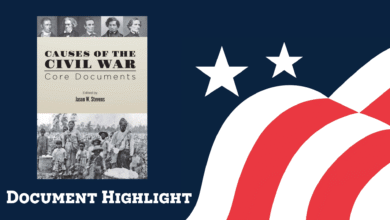
Teaching American History provides various free resources for American history and government teachers, including our popular seminars, multi-day seminars, and extensive database of original source documents. Still, to paraphrase a famous campaign slogan from the 1990s, for TAH, it’s the documents, stupid! Seriously, that’s because we believe the best way to learn about American history and government is by bringing the words of those who lived it into the classroom.
Most teachers discover our database when searching for a specific document. When our site pops up in the search results, and they click on our site, they see that we have thousands of primary source documents, many accompanied by introductions and study questions. Still, here are some tips that help you locate documents you want to use with your students.
Say you want to use Thomas Jefferson’s letter to John Holmes expressing his concerns about the Missouri Compromise. There are several ways to search for the letter. You could enter Thomas Jefferson to John Holmes in the search bar on the documents page. This is the best way to find a specific document. The more information you have, the better. However, you may not know who the recipient of a letter was. In that case, you could search for the documents authored by Thomas Jefferson by typing only his name into the search field. We have 93 Jefferson documents in our collection, so you must dig further. You know the Missouri Compromise was in 1820. If you search “Jefferson 1820,” 49 documents are listed. The first is Jefferson’s letter to Holmes. One more pointer. Our author drop-down menu lists authors alphabetically by first name, not last.
Suppose you are looking for something other than a specific document. You may hope to find a new document that will freshen your approach to teaching a particular topic. In that case, we recommend you explore our Core Document volumes. Our Core Document volumes are curated by scholars, with each book focusing on a specific topic. Titles include Reconstruction, Native Americans, Gender and Equality, Slavery and Its Consequences, and The Great Depression and the New Deal. Each book has an introduction, as does each document in the book. Each collection also contains study questions to use with students, and a thamtic table of contents which groups the documents according to the collection’s key themes. Study questions, arranged in pairs, include one question relevant to a single document and a second question that pairs each document in the collection with others in the collection.
Two Core Document Collections cover the entire scope of American history. Documents and Debates volumes 1 and 2 each contain 15 chapters that together cover American history from 1493 to 2009. Each chapter consists documents that present different views on a key issue. Chapter 1 in Volume 1 is titled “Early Contact.” Volume 2 concludes with a chapter called “America and the World.” Each chapter is a case study that can be printed and shared with students or linked to a classroom management program for lessons during several class periods.
All Core Document paperback volumes are available to purchase for $12.99 in the TAH bookstore. You can also choose to download a FREE PDF version of the book.

Ray Tyler was the 2014 James Madison Fellow for South Carolina and a 2016 graduate of Ashland University’s Masters Program in American History and Government. Ray is a former Teacher Program Manager for TAH and a frequent contributor to our blog.






